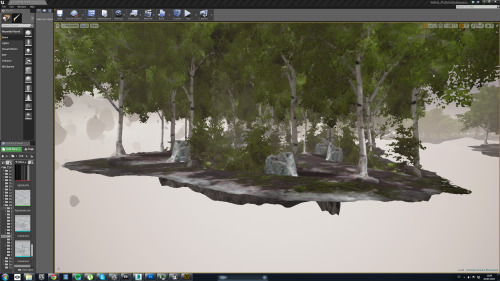Hi everyone!
I am Carlos Coronado and this is the thread where I will be posting all the stuff I am doing while redoing MIND: Path to Thalamus (already released and done in UDK) for UE4. You must know I am redoing the game with VR in my mind, so all the changes in the environmets are because Vr. For example, less alpha test in the forest. I really like how the new forest is doing. I have also done a new locomotive system for VR and I will show that soon too (done with blueprints of course). This new system includes a working in game menu (not a launcher) with toons of settings! **Part of the purpose of this forest is also to be part of the menu map, so when the player changes the settings he can see instantly the results in the level **![]() It is going to be a looong looong road but the engine is amazing and I am having a lot of fun with it so one step at a time!
It is going to be a looong looong road but the engine is amazing and I am having a lot of fun with it so one step at a time!
The floor of the forest are just some static meshes with vertex paint. In the second image you can see some of the vertex textures. No normalmaps whatsoever. All are only diffuse maps! Photogrammetry is such an amazing technique for scenes like this ones! I was really inspired by the work done in The Vanising of Ethan Carter so I went on a trip with my girl to El Montseny and we did a nice walk to the top of the mountain and in the mean time I did some photos to stones lol. This is the amazing aspect of photogrammetry: you can work while you are having fun IN THE OUTSIDE! ![]() Processing the files to get them working in UE4 is a semi automatic process also: I used Photoscan and Zbrush just for the ZRemesher tool. That tool is nuts! All the photos where taken with an old cannon 1000D with a 18-55mm in P mode with 200 ISO. No tripode or special equipment. Always looking for ways to be more efficient! Doing stones and floors like those ones by hand would have taken me ages… with photogrammetry just a trip and 2 days of works for all the assets! I made a tutorial about photogrammetry and UE4 but now it is only aviable in Spanishbut I will translate it soon!
Processing the files to get them working in UE4 is a semi automatic process also: I used Photoscan and Zbrush just for the ZRemesher tool. That tool is nuts! All the photos where taken with an old cannon 1000D with a 18-55mm in P mode with 200 ISO. No tripode or special equipment. Always looking for ways to be more efficient! Doing stones and floors like those ones by hand would have taken me ages… with photogrammetry just a trip and 2 days of works for all the assets! I made a tutorial about photogrammetry and UE4 but now it is only aviable in Spanishbut I will translate it soon!
I would have loved to be in the GDC this year and meet some of you people and share some thoughts about UE4 and game developent but well… I am doing what I can! The trip from Spain is really expensive and right now there are unfortunally other priorities for me. Hope you have a great time there and gdc Europe is a thing for me!! ![]()
Btw, this is NOT going to be a new game. The users who have the game will get a free update when I am done with the work ![]() I owe them than! They are such an amazing community!
I owe them than! They are such an amazing community!


 Looking forward to updates!
Looking forward to updates!





